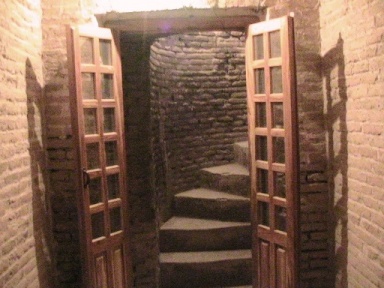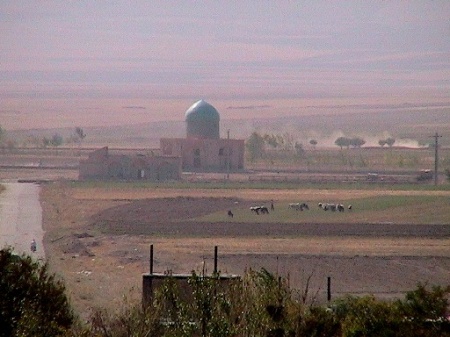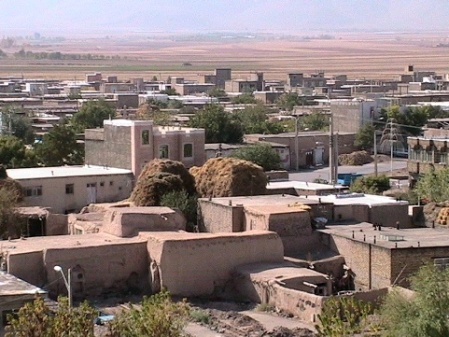Through a narrow passage, a long series of stairs, lead to the upper balconies

NO: 21

NO: 22
The stairs, in contrast to the basement, lead to a beautiful veranda, at two levels, running all around the dome?

NO: 23
The veranda has magnificent decorative brick and tile works

NO: 24
And provides a magnificent view of the plains around the mausoleum

NO: 25

NO; 26
And the view looking inside

NO: 27
The veranda boasts many beautiful tile works

NO: 28
It was lunch time and everybody was hungry. Through the lazy streets of the sleepy town we tried to find a place to eat breakfast at about 12.00 noon, little late for breakfast?

NO: 29
The monuments in the city square signify to currant artistic taste of the town contrasting with the highly developed and magnificent taste of the mighty architects and designers who built the soltaniyeh mosque.

NO; 30
We eventually found a small restaurant, or more correctly a tea house and had a big branch of eggs, bread and tea.

NO; 31
A Last look at all that remained of the past grandeur that once was, and off we were to Zanjan

No: 32
And off we were to takht-e soleyman (see part on takht-e soleyman in this blog) but first to zanjan, another 100 kilometer of highway with very little traffic. A field on our way attracted my attention; from the distance it appeared as if they were growing nylon bags

No: 33
History of soltaniyeh
Geographical location
Soltaniyeh (soltanieh) is located on a high plateau – about 2000 meters above sea level – boxed between to mountain ranges on its north and south running in a east west direction

NO: 33a
Soltaniyeh has no surface running water, due to type of porous soil all water goes underground, and hence it has a rich supply of underground water. It has large grassland that has always attracted the nomadic people
Soltaniyeh in the old days was situated on the trade cross routes connecting two major trade routes:
The
- East / west trade route connecting Mesopotamia and Europe to china
- North south route connecting south and north Iran

NO: 33b
Soltaniyeh in spit of its strategic commercial location, the merger historical or archaeological data dose not indicate it ever being a prosperous civilization center, before it was selected as capital by a Mongol emperor, like Tabriz, Zanjan, qazvin or Rey, perhaps it is because of its very could winters
Historical background – from pre history to Mongols
Soltaniyeh is a relatively a new name given to this place in 13 century by the Mongols but historical records or archeological finds referring to this place are very few .
- Archeologist working around soltaniyeh, especially near the current city (especially on tapeh nour (hill of light) – old soltaniyeh), have found traces of settlement going back to 4000 to 1000 BC.
- According to Assyrian tablets an Aryan tribe (sagarit?) used to live in this place around 700 BC.
- The Medes used to call this place “Ariba”
- The Parthians referred to it as “Erasa”
- The large grass land of soltaniyeh had always attracted nomadic tribes, after the Mongol invasion a Mongol tribe called “Ghonghor” settled in this area and called it “Ghonghor o-leng” meaning the grass of Ghonghor.
It is only sometime after the Mongols conquered Persia and setup the ilkhanate dynasty and moved their capital to this place that soltaniyeh appears on historical radar screens.
Soltaniyeh and the Mongols (ilkhanate)
Soltaniyeh was built by sultan Mohammad oljeitu whose linage goes back to Genghis khan
Genghis khan
Hulagu khan (1256 – 1265) – founder of ilkhanate dynasty
Abaqa khan (1265 – 1282)
Arghuan khan (1282 – 1284)
Mahmud ghazan khan (1295 – 1304)
Sultan Mohammad khoda bande (oljeitu) (1304 – 1316)
Arghuan khan a great builder and states man, was the first to show interest in soltaniyeh either because of its grass land or its strategic commercial value
Ghazan khan – initially a Buddhist, and a later converted to Islam – started to develop soltaniyeh – perhaps due to its commercial potential – but did not get very far with this development
At this time soltaniyeh was a Christian center with numerous churches an about 500 followers or more
It was sultan Mohammad khoda bandeh who developed soltaniyeh; he started work on soltaniyeh in 1302, and move the ilkhanate capital from well developed Tabriz to soltaniyeh in1316.
The intensity of sultan khoda bandh’s effort to develop soltaniyeh was such that it has given rise to number of speculations regarding his motives for such action
Religious
Sultan Mohammad was born to a Christian mother and baptized as Nikolas. Latter on after he took a Persian wife he converted to Islam (hanafi branch).
Latter on, his advisors persuaded him to convert to change to shafei sect of Islam – he was not a very devote mausoleum and a heavy drinker – and therefore it is quite probable that he had political motives in this change of religion.
So it is clamed that he initially intended to build a church in soltaniyeh. The on conversion to Islam (shafei) he decided to build a shrine for the shi’a martyrs buried in Karbala – current day Iraq – and to move their remains from Karbala to soltaniyeh.
As expected this move meth with lot of opposition and the idea of shrine was abandoned and it was then turned into a mausoleum for the Mongol sultans. Some object to this hypostasis on the ground that Mongols did not have a tradition of burying their dead in mausoleums.
Commercial
Moving the capital from well developed Tabriz to middle of now where sultanate, considering the cost and inconvenience and opposition by nobility must have had a very strong motives, at least in the mind of the sultan or perhaps some of the advisors.
The first motive that comes to mind is commercial; perhaps in this move they sow such increase of trade in the Europe china direction that justified this drastic action
Ego usually provides by far a stronger incentive in many instances. A young man wishing to make a name for him self – without going to war – as well as perhaps following his fathers foot steps
Although moving the capital is nothing new and it has been done many times in history, but this time soltaniyeh – very much like Petra in Saudi Arabia – did not have what it took to maintain a great city for very long. The city flourished during the life of its patron for a short while. So say that its decay started with death of sultan Mohammad, and after his death many of the nobility and the craftsman left for their home towns
Giosofat Barbara (1349) refers to soltaniyeh as an important commercial city with perhaps 6000 inhabitants.
Timur (1370 -1405) destroyed soltaniyeh and his son, Miran shah, after destroying much of buildings in Tabriz decided to destroy the remainder of soltaniyeh. What is puzzling is that both Timur and his son both respected the mausoleum?
After these event soltaniyeh fell into disuse to the extent that Jean Baptiste Tavernier (1632 AD) describes Soltaniyeh as a ghost town, and after this soltaniyeh never recovered
Soltaniyeh architecture
After the Arabs conquered Persia some of the Iranians migrated east to current day Afghanistan and beyond and eventually set up two dynasties their with Persian culture and Islam as religion
These dynasties had in their service Turks from central Asia, the Turks became indoctrinated in the Persian culture in their 120 year long service but eventually rebelled against their masters to setup the Ghaznaviyan Empire that ruled all of current day Persia and much more.
Ghaznavids where Muslims with Persian culture, they inherited much of architecture and arts of old Iranians and the Persian culture flourishes during their reign
The Mongols inherited the last of this culture glimpse of which we can see in sultanate. Soltaniyeh is the worlds highest brick dome, 49 meters from the base with a weight of 200 ton
It is believed that soltaniyeh inspired other buildings in Islamic lands such as Tajmahal or
Tags: History, images, soltanieh, Soltaniyeh, soltaniyeh mausoleum, soltaniyeh mosque, soltaniyeh shrine
Leave a comment